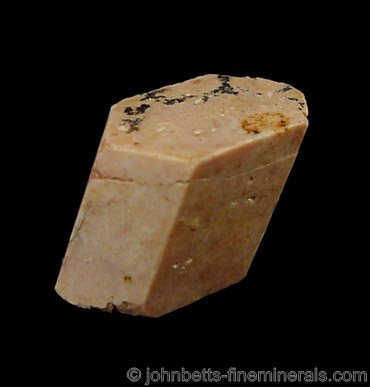The Mineral orthoclase

Orthoclase is one of the most common minerals, and occurs in numerous mineral environments. It is polymorphous with the minerals Microcline and Sanidine. These three minerals form the Potassium Feldspar group. They are almost identical in physical properties, and it is sometimes impossible to distinguish one another without x-ray analysis. The only difference between them is their crystal structure. Microcline crystallizes in the triclinic system, and Orthoclase and Sanidine crystallize in the monoclinic system. Sanidine forms at high temperatures and has a disordered monoclinic symmetry, whereas Orthoclase forms at low temperatures and cools slowly, forming more ordered monoclinic crystals.
In some mineral reference guides, Microcline and Sanidine are wrongly categorized as variety of Orthoclase. Since it is so difficult to distinguish between Orthoclase, Sanidine, and Microcline, they may be simply called "Potassium Feldspar".
Chemical Formula
KAlSi3O8
Color
White, yellow, colorless, pink, orange, light blue, light green, brown, gray
Crystal System
Monoclinic
Properties
Streak
White |
Hardness
6 |
Transparency
Transparent to opaque |
Specific Gravity
2.6 |
Luster
Vitreous to pearly |
Cleavage
2,1 - basal ; 2,1 - prismatic ; 3,1 - pinacoidal. The cleavage angle is about 90º. |
Fracture
Conchoidal to uneven |
Tenacity
Brittle |
Varieties
-
Describes a transparent, yellow variety of Orthoclase from Madagascar.
Uses
Orthoclase is industrially important in the manufacture of glass and ceramics. Orthoclase crystals and twins provide information on the formation of minerals and environmental factors. Well shaped crystals and twins are highly sought after by mineral collectors, and the Moonstone variety is used as a gemstone.
For additional information, see the gemstone section on Orthoclase and Moonstone.
Noteworthy Localities
Orthoclase is one of the most common minerals, and is found worldwide. Only a select few localities are mentioned.
The original Carlsbad twins were described from Karlovy Vary (Carlsbad), Bohemia, Czech Republic. Some of the best crystals come from Baveno, Piedmont, Italy, especially the famous Baveno twins. Good crystals come from San Piero in Campo on the Island of Elba, Italy; and Zarzalejo, Madrid, Spain; Switzerland contains numerous good localities in the pegmatites of Uri.
Light blue crystals came from the the Lake Baikal area in Russia, and large masses from Mt. Kilimanjaro, Tanzania. Transparent gemmy yellow crystals that have recently become very popular come from a pegmatite in Madagascar, at Itrongay, Tulear Province.
In the U.S., enormous crystals were found on Sandia Mountain, Bernalillo Co, New Mexico. Good collector specimens have come from the Organ Mountains, Dona Ana Co., New Mexico; Robinson Gulch, Jefferson Co., Colorado; and Goodsprings, Clark Co., Nevada. Orthoclase has also come from the French Creek mine, St. Peters, Chester Co., Pennsylvania.
Distingushing Similar Minerals
Sanidine - Indistinguishable without complex methods. Sanidine, however, is never opaque.
Microcline - Indistinguishable without complex methods. However, Microcline can have a deep green color that Orthoclase cannot achieve.
Plagioclase Feldspars - May exhibit striations on twinned crystal surfaces, otherwise difficult to distinguish.
Spodumene - Has a splintery fracture.
Calcite - much softer (3).